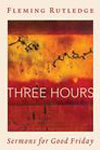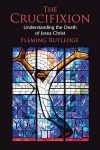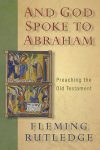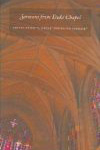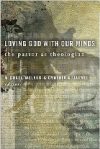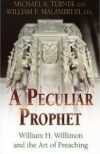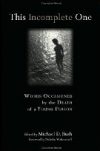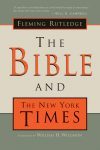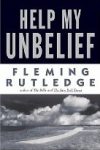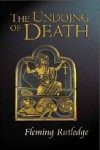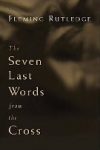by Fleming Rutledge
At Passover time, 2001, Rabbi David Wolpe delivered an address to two thousand members of his congregation at the Sinai Temple in Los Angeles, throwing them and a considerable number of other local Jews and Christians into confusion when his remarks were repeated in the newspapers. Here is part of what he said:
The truth is that virtually every archaeologist who has investigated the story of the Exodus, with very few exceptions, agrees that the way the Bible describes the Exodus is not the way it happened, if it happened at all. (emphasis added)
Can you imagine saying something like that in a sermon on one of the highest holy days of the year? Well, a great many prominent Christian clergy have done so, using Easter Day, for example, as an opportunity to cast doubt on the Resurrection.
Rabbi Wolpe made his remarks in the context of the new archaeological landscape. The dramatic advances of the last 20 years have indeed created an entirely new situation for those who are interested in the Bible. There are still many clergy in the mainline denominations who were trained in the days of the “Albright synthesis” of archaeology with Biblical studies (named for the legendary scholar William F. Albright). In the 50s and 60s we took it for granted: the more the “Biblical archaeologists” dug up, the more it would prove that the Bible was grounded in demonstrable “facts on the ground.” We relied upon the celebrated dictum from the archaeologist Nelson Glueck, an ordained rabbi, who wrote in 1959, “It may be stated categorically that no archaeological discovery has ever controverted a Biblical reference.” In the decades since then, as a preacher mining the Scriptures for the purpose of proclamation, I did not pay much attention to the new developments in archaeology. I therefore might not have learned that the Albright synthesis had broken down if I had not begun (within the last five years) to see articles in newspapers and magazines with titles like “The Bible Flunks New Archaeological Tests” (New York Times, 7/29/2000).
I therefore took a month’s vacation from my usual reading, early this summer, to bone up on the current state of archaeology in the lands of the Bible. I read some terrific books, three of them (listed below). Was this necessary? Do we have to bone up on this subject in order to preach the gospel, or to believe the truth of the Scriptures, the Old Testament in particular?
No and yes, in that order.
No, in the sense that the revelation of God’s self in the Old and New Testament Scriptures is not dependent on “what really happened.” (The exception, I would argue, is the case of the Crucifixion of Jesus Christ, upon which the truth and meaning, though not the mode, of the Resurrection entirely depends.) The revered American writer Joseph Mitchell, who was my friend, is believably reported to have said, “I’m not interested in facts. I’m interested in truth.” If the truth of the Bible is dependent on the conclusions of modern, scientific archaeology, the entire tradition of African-American preaching (to use only one example) would have to be jettisoned.
So, no, preachers don’t have to know about archaeology. But yes, because the metamorphosis of what used to be called “Biblical archaeology” into “Near Eastern” (or “Syro-Palestinian” or “Levantine”) archaeology poses a new set of challenges for interpreters, and it would be irresponsible if none of us were paying attention. Educated preachers and lay people should have at least some sense of the issues. I am therefore offering an overview of the present debate, interspersed with some suggestions for preachers (and anyone else interested in Biblical interpretation).
The archaeologist best known to the general public for his highly readable books about the state of “Biblical archaeology” today is the prolific William G. Dever. In addition to his reputation as an exciting lecturer for general audiences, Dever is frequently described as the leading Near Eastern (Levantine) archaeologist of the generation since G. Ernest Wright.[1]
A few weeks after Rabbi Wolpe’s controversial remarks, Dever attracted a standing-room only audience at another temple in Los Angeles for his lecture in the subject, “Who Were the Early Israelites?” Dever has been virtually the only archaeologist willing to talk with Biblical scholars in dialogue “between text and artifact.” In this role (which he obviously relishes), he takes regular hits from both right and left, from evangelical Christians and conservative Jews on the right, and from the “revisionists”
on the far left. An enthusiastic polemicist, he dishes out as much scorn as he
receives. It makes for very lively reading.
Among Professor Dever’s many books I chose two of the most recent ones: Who Were the Early Israelites and Where Did They Come From? and What Did the Biblical Writers Know and When Did They Know It? (both from Eerdmans) Dever loves his discipline, is passionately committed to it, and has spent decades fighting to be heard. He is arguing as passionately as he can for the new ways of thinking about archaeological discoveries. He is especially illuminating as he describes today’s emphasis on “material culture,” which is painstakingly deduced from the excavations, layer by layer. This exacting scientific work stands in sharp contrast to the long outdated popular conception of the archaeologist as an adventurer, digging up buried gold and discovering lost Arks. Today, conclusions are drawn from such mundane artifacts as shards of pottery, kernels of grain, and bones of animals.
The explosion of new discoveries and new models began after the Six-Day War in 1967. Archaeologists swarmed upon the newly opened West Bank. The first explorations were hasty and superficial because at that time no one knew how long the Israelis would hold “Judea and Samaria” (the West Bank), but in 1978 a much more extensive series of projects were begun, led largely by young archaeologists from Tel Aviv University. Dever writes, “these surveys in the West Bank continued for nearly a decade and produced such an astonishing wealth of data that they totally revolutionized our understanding of the origins of ancient Israel.”[2]
The third book that I read is a collection of 19 essays by relatively conservative scholars, The Future of Biblical Archaeology: Reassessing Methodologies and Assumptions (Eerdmans, 2004). Remarkably, the preface and the first six essays in this book begin almost exactly the same way: “In the 1970s William G. Dever fired a shot across our bows…” “In his 2001 diatribe against the minimalists, William G. Dever argues…”[3] As this same introduction, with variations, repeats itself in essay after essay, it becomes almost laughable. Clearly, Dever is far and away the leading figure for anyone interested in archaeology as it is related to the Hebrew Bible. He is almost the only professional archaeologist who is interested in serious discussion with Christian and Jewish believers.
Dever’s own religious commitments are anything but orthodox. Raised in a Christian home by a fundamentalist-preacher father whom he admired and loved, he nevertheless turned away from Christian faith, and now says he is “a secular humanist,” though he has chosen to adopt a Jewish identity. He describes himself as a “non-theist.” Is that different from an atheist? One wonders, since he seems to differentiate himself from atheists. In any case, like many other brilliant people in various fields who comment on the Bible, he is theologically tone-deaf. His project is therefore of limited usefulness for those who would understand the Bible theologically.
What Dever does do—and this is what makes him so interesting for interpreters—is to present himself, accurately enough, as an ally of those who seek a historical grounding for the Old Testament texts. His focus is the Iron Age, which stretches approximately from 1200 to 600 BC, from the early settlement of the Canaanite hill country to the Babylonian conquest. Dever argues that the new archaeological discoveries from the Iron Age actually support the accounts in Judges, I and II Kings, and I and II Chronicles to an extraordinary degree. Hence, his thesis that “the Biblical writers knew a lot, and they knew it early.”
Dever, therefore—and this is important for interpreters to note—is a specialist in a discipline devoted to “facts on the ground.” In this latter respect he resembles a historical-critical Biblical scholar of 50 years ago. This explains his favorable attitude to some of Jack Spong’s work, since they are both remarkably wedded to a material (and in Spong’s case almost literal) way of reading the Biblical text. Indeed, though Dever is more serious and at the same time more secure in himself than Spong, the two are not dissimilar in their focus on that which can be scientifically shown to be factual and comprehensible to the “modern” and “rational” mind. If Sam Harris’ lecture on C-Span is anything to judge by, he too is a singularly unimaginative, literal-minded reader of the Bible. It makes one want to cheer for postmodernism.
It will be readily seen that such an approach to scientifically demonstrable facts makes God redundant. A particularly striking example of this appears in Dever’s treatment of the non-historical, or at any rate non-substantiated Exodus narrative. Dever sees meaning in the story, and his description of this meaning is quite moving. However—and this is the point—the meaning that he sees is an experience of human liberation quite apart from God.[4] To use another example, he is thrilled with the convergences, as he calls them, between some of the Biblical texts [I and II Kings being his particular focus] and the material culture deduced from the artifacts from the hill country. Indeed, these links are quite exciting—up to a point. It’s nice to know that there is so much reliable information in these portions of the Hebrew Scriptures. But how far does this take us? Dever shows how close the “convergences” are between text and artifact in the period between Solomon and the Babylonian conquest—leading, in his view, to some degree of confidence in the history lying behind the Old Testament accounts of this particular period. For Dever, it means “sure knowledge.”[5]
But what sort of knowledge is this? Divine revelation clearly is eliminated from the beginning. Suppose that we agree that there is a remarkable similarity between the conditions described in Judges and I-II Kings and those uncovered in the excavations. What does that mean for Christian proclamation? Does that mean the Old Testament is only partly “true”? Does it mean that other Biblical books (the Pentateuch, in particular) have no truth in them because the conditions in them do not fit the facts on the ground? And where is God in all this?
Dever’s books are valuable for their clear delineation of the varying positions on the spectrum of the archaeologists working today. He identifies three groups of
scientists and other scholars working with the texts of the Old Testament: </o:
1. The centrists are led by Dever who identifies himself as a “moderate.”Dever initiated the move to replace the term “Biblical archaeology” with “Near Eastern archaeology” and he has rejected Christianity, but he has a genuine passion for the story of Israel and seeks to honor it in his work even as he opposes “positivism.”
2. The “conservatives,” “maximalists,” or “positivists,” are struggling to overcome the accusations of their peers who believe (not without cause) that they bring religious bias to archaeological research. Many of the conservatives are the heirs of the famous American Protestant “Albright school” of “Biblical archaeology” which bestrode the scene until about 1970. In the face of great archaeological disappointments in the past decades, this group must now struggle to counteract the widespread suspicion in the academy that their primary agenda was (and is) to “prove” that the Bible is “true.”
3. The “revisionists” or “minimalists,” have been centered at the University of Sheffield (England), with another branch referred to as the “Copenhagen school.” These scholars are not generally archaeologists themselves (much to Dever’s annoyance), but they have seized upon the perceived failure of “biblical archaeology” to promote radically skeptical views of their own. They ignore the actual archaeological data but take the opportunity to exaggerate the paucity of archaeological “proofs” to suggest that there is nothing historically factual behind the Bible at all. Dever has mounted scathing attacks on these revisionists at every level, going so far as to accuse them of fascistic tendencies and a hint of anti-Semitism. His arguments are so strong as to be startling at times, but they have much merit in them. In a separate piece at the end of this one, I will make some further comments about this.
Although Dever works very hard to build bridges, his concept of who is and is not a “Biblical scholar” seems curiously limited to university religion professors, and only in limited quantities at that. If he knows anything about key figures in Old Testament theology such as Claus Westermann and Walter Brueggemann, he
shows no sign of it. In fact, he is rather dismissive of professors in seminaries and other church-related institutions, presumably because he associates their confessional stance with the now-discredited “Biblical archaeology.” This is odd, however, because he makes such a point of seeking dialogue across disciplines. Apparently he does not think of genuine Old Testament theology as an authentic discipline (his occasional use of the term theology in his own work is inexact, since he is a self-described non-theist).
Is Dever’s lack of interest in Biblical theology related to his lack of sympathy for and understanding of the valid aspects of postmodernism (loosely defined) I think it is. He uses a lot of space to heap scorn on the postmodern literary project, showing little interest in literary, symbolic, or metaphorical meaning. There are one or two notable exceptions; we have already noted that he speaks fervently and persuasively of the Exodus as a living, powerfully recreative “metaphor of liberation” which continues to resonate today in communities of every kind. To give him credit, he is particularly compelling when he talks about how his family came from Ireland during the potato famine in an exodus of their own. Likening the Passover Haggadah to the American Thanksgiving Day, he affirms:
“Despite the diversity of [our] origins…all we Americans metaphorically came over on the Mayflower…on this holiday spiritually (yes!) we are all Pilgrims, newcomers to our own Promised Land. That is what makes us Americans. An origin myth? To be sure—an extraordinarily powerful one, constitutive of a great nation. And, of course, derived from the original Biblical myth of the Exodus.”
This is great stuff, even for me, an eighth-generation Virginian who was brought up on the “origin myth” of Jamestown, Pocahontas and Captain John Smith. In fact, it is noteworthy that, in spite of the efforts of various Virginia chauvinists, the Jamestown saga has never attained the stature of the one from Plymouth Rock. The reasons are obvious: the more commercial Jamestown venture lacks the high theme of religious and political freedom, the sense that something new was coming into being. Dever is very good at describing the way the motif of deliverance in the story of the Exodus becomes a universal metanarrative (to borrow a trendy post-modern term) of liberation.
But something is missing in all this. What is it?
God is missing. In spite of Dever’s stated intent to seek a theological meaning behind the “origin myth” of the Exodus, there is no theos on his horizon. His use of the vague, generic term “spiritual” is the tip-off. For him, this is a story about “who we are…spiritually,” not about who theos is.[6]
In the section that ends his book Who Were the Early Israelites…? with a supposedly ringing conclusion, it emerges that what Dever means by “theological” is his argument that there might have been an actual, historical “charismatic, sheikh-like leader with the Egyptian name of Moses.”[7]
It is of the most intense importance to him that the story have a kernel of
historical fact, but he has abandoned the search for truth about God. Dever
fails to understand the living dynamism of the Biblical narrative, so that for
him the historical question is always the controlling one.
This brief description of the empty space where theology ought to be summarizes the primary insufficiency of Dever’s project for preaching and for the teaching of Scripture for the Church. There is much, however, in his work that is of interest for those who want to dig deeper into the hermeneutical challenges. What follows, then, is a quick sketch of some of the contemporary work “on the ground” which will help us to think about those interpretive challenges.
The Conquest: a growing consensus of archaeological/historical opinion:
J. Maxwell Miller is co-author of the widely used History of Ancient Israel and Judah (1986). He writes: “Earliest Israel was probably a loose confederation of tribes and clans that ’emerged’ gradually from the pluralistic population of the land. Accordingly, Israel’s ancestors would have been of diverse origins. Some may have been immigrants from Transjordan, possibly even from Egypt. But basically Israel seems to have emerged from the melting pot of peoples already in the land of Canaan at the beginning of the Iron Age.” Dever quotes this passage as a good summary of the emerging consensus, still valid in 2003 and presumably today. [8]
Therefore it seems that there is no archaeological evidence that any migration from Mesopotamia to Canaan ever took place, let alone that there was a historical figure called Abraham. Dever says that he gave up searching for the historical Abraham “a long time ago.”[9]
As I have already suggested, this sort of statement presents the preacher with a dilemma not entirely unlike that presented by the Jesus seminar, although most revisionists would agree that a person called Jesus of Nazareth did actually exist. Everyone in the profession of preaching (and many thinking people in the pews as well) must wrestle with the challenges brought against the Bible, and against the church’s preaching of Christ, on the grounds of “historicity.”
No scientific evidence for a Biblical-scale Exodus has been discovered. At the same time, however, it can be said that a limited and demythologized version of an exodus of a small number of people from Egypt to Canaan is at least possible historically (though it would be of no interest homiletically). The most solidly grounded archaeological refutation, however, seems to be the matter of the Conquest of Canaan under the leadership of Joshua. Dever thinks that the digs have conclusively shown that the descriptions of local conditions described in the book of Judges have largely been vindicated by the excavations, but a sweeping military victory of the sort depicted in the book of Joshua simply did not happen.[10] How should we incorporate these contradictory findings into our interpretation of the living Word of God?
From our contemporary perspective, there is no more problematic section of the Old Testament than chapters 6-11 of Joshua, with their scenes of wholesale, unremitting slaughter—beginning with the “utter destruction” of Jericho and everyone in it, including even the animals. Indeed we are told that “there was not a city that made peace with the people of Israel…they took all in battle. For it was the Lord’s doing to harden their hearts that they should come against Israel in battle, in order that they should be utterly destroyed, and should receive no mercy but be exterminated, as the Lord commanded Moses” (Joshua 11:19-20).
But how literally are we meant to take these stories? Storytelling by its very nature has a quality of artifice; when children hear the story of Hansel and Gretel they are quite satisfied to learn that, in the end, the wicked witch is pushed alive into the furnace and burned to death. No one is thinking of the details of such a gruesome death; the point is to rejoice in the deliverance of the two courageous children. Reputable child psychologists have warned against adult moralizing in such cases; children have an instinctive grasp of the central trajectory of the narratives, and it spoils their imaginations to insist on dissecting the stories in order to extract a lesson.
Here is another angle on this issue. I have always loved the famous Biblical illustrations of Gustave Doré, but when I acquired a copy of the complete series, I was horrified by some of the pictures. It is quite one thing to read that Queen Jezebel’s body was devoured by dogs so completely that only “the skull and the feet and the palms of her hands” remained, and quite another to see it graphically illustrated. I would not hesitate to read the story about the end of Jezebel to my young grandchildren, but I have cut the illustration out of the book and shut it up in a file.
Suppose archaeology were to demonstrate that the death of the “historical Jezebel” was exactly as described. That would not make any difference whatsoever, it seems to me, to the overall impact of the stories in the Elijah cycle, which has little to do with literal interpretation in any case. The overall impact depends for its force upon the hearers’ faith in the power of the living God, identified by Elijah in his address to King Ahab: “As the Lord the God of Israel lives, before whom I stand.” The clear implication here is that even though Elijah is “standing before” Ahab and Jezebel, this is not where he has his feet planted; his true allegiance is to God alone. It is not possible to understand this unless one is able to think in more than one dimension. Moreover, the Elijah cycle demonstrates that the God of Israel is indeed living and powerful—as is matchlessly described in the story of the contest on Mount Carmel. The point of the story is the impotence of Ba’al and the corresponding might of Yahweh. We are to hear the story with awe and wonder. If we focus in a literal-minded way on the consequent slaughter of the priests of Ba’al, we are violating every principle of listening to, and inhabiting, a story—as surely as if we were to start worrying about the poor witch being burned alive. Stories do not work on that level, and it would be sadly impoverishing if we thought they did.
I am suggesting that the power of narrative is primal and foundational for understanding Scripture and for preaching. A friend of mine once said, only partly in jest, that the story of Santa Claus trained children to imagine transcendence. Certainly the great storytellers of our time like C. S. Lewis, J. R. R. Tolkien, and now J. T. Rowling have demonstrated how a narrative can carry us along, suspending disbelief, to a powerful resolution—even, in some cases, to theophany.
Perhaps, however, we have lost, to some extent, the ability to hear and to enter into stories unless they are on a screen. We seem to be more literal-minded (dare I say “fundamentalist”?) than our forebears. We do not read much poetry; imaginative literature has morphed into video games. Parents are too busy and distracted to read to their children, and when every classic story is made into a movie, few (if my own grandchildren are examples) will go back and read the unabridged originals. Surely this is a mistake. Parents and teachers can still be encouraged to take seriously the importance of training children in wonder by retelling the classic tales straight, without trying to extract morals or politically correct lessons from them.
In the collected sermons of the great (albeit Arminian) 19th-century preacher Alexander McLaren, there are no fewer than fifteen from the book of Joshua. McLaren sees no difficulty in preaching from Joshua. If the text says that Joshua commanded the sun to stand still over Gibeon, McLaren wastes no time speculating about whether that really happened. He takes the opportunity to spin out a gorgeous meditation on faith in the power of God. G. F. Handel’s Joshua, like all of his Old Testament oratorios, takes liberties with the text, but the overall effect of the sun-stopping episode upon the believing listener is, it seems to me, thrillingly close to what the Biblical writers/editors intend that we should know about God’s lordship of creation. We might say the same about Jesus stilling the storm upon the Sea of Galilee.
The text, then, has universal power in and of itself, and as soon as we begin imposing our own agendas or assumptions upon it, its universality is fatally diminished. If this is true, however, the question now arises as to the connection, if any, between the text and a God who lives independently of the text. I have already suggested that the postmodernist approach to Biblical narrative has been a cleansing wind in some respects, but the charge has been brought that for these interpreters, the text itself has taken the place of God. It is surprisingly similar to the standard complaint about fundamentalists—that they have deified the text.
Take for instance the important and very interesting case of Walter Brueggemann. It would be fair to say that he has jettisoned the historical question altogether in the interests of a rhetorical reading of the text. From this perspective Brueggemann would perhaps agree with Martin Noth, the noted German Biblical scholar, who wrote in the 1950s that “archaeology is mute (dumm).” This is the sort of attitude that causes a scientist like Dever to become apoplectic, but Brueggemann similarly writes that historical criticism and scientific inquiry have reached the end of the road and are no longer useful for the Church. Many of us who were trained in these methods would agree that they have had a pernicious effect on proclamation. But what does Brueggemann substitute?
Brueggemann’s rejection of the historical-critical method has led him to an often-quoted conclusion. He writes, ‘I shall insist, as consistently as I can, that the God of Old Testament theology as such lives in, with, and under the rhetorical enterprise of this text, and nowhere else and in no other way'” (66). It is remarkable how that statement takes on different connotations in different contexts. When I first came upon it toward the beginning of Brueggemann’s Old Testament theology, it struck me very favorably. I read it in the context of the eclectic “New Age” spirituality which is such a major component of the environment in which I work. Over against this syncretism, it seemed to me that Brueggemann was making the welcome point that the God of Abraham, Isaac and Jacob cannot be known by communing with nature or by doing tantric yoga or by walking a labyrinth. God is known through the writings of the Old Testament and New Testament and nowhere else. Similarly, it is incontrovertible that we have no access whatsoever to Jesus of Nazareth except what we know of him through the New Testament, that is, through the church’s confession of him as the Christ. In this regard, therefore, Brueggemann’s declaration is most welcome
However, there is another way to look at Brueggemann’s description of his massive project. In a long essay-review of his Old Testament theology, Ellen Davis, an exceptionally gifted scholar and preacher (a combination rarely found today) has challenged his position head-on.[11]
She begins by praising Brueggemann in no uncertain terms for his life-long commitment to the revolutionary dynamism of the Old Testament texts and for being the person who, perhaps more than any other scholar of his generation, has made these texts in all their intransigent strangeness “too interesting to ignore.” Moreover, she applauds him for seeking to take the texts out of the hands of the “technicians” and restore it to the ordinary believer, showing how “the Old Testament is too hope-filled to be left wholly in the hands of specialists.”
Davis then launches a critique that is both deep and wide. She writes,
“It is in the interest of promoting openness in the interpretive conversation that the most troublesome aspect of Brueggemann’s argument arises…In giving rhetoric primacy, Brueggemann repudiates the ‘essentialist tradition’ of Christian theology. Among contemporary scholars, he identifies Brevard Childs as the major proponent of this [essentialist] position…In response to Childs’ reference to ‘the reality of God’ behind the Biblical text, Brueggemann responds, ‘In terms of Old Testament theology, however, one must ask, What reality? Where behind?’ Thus Brueggemann states his own emphatically non-essentialist argument: ‘I shall insist…that the God of Old Testament theology as such lives in, with, and under the rhetorical enterprise of this text, and nowhere else and in no other way.'”
If Davis is right, then Brueggemann’s declaration of purpose, which I have twice quoted, is more alarming than I first thought when I admired it out of context.
“I hope to show [Davis writes] that the non-essentialist argument as Brueggemann presents it here is deeply flawed in both its genesis and its consequences, and that in both respects it runs counter to the fundamental aims that are evident in the larger body of Brueggemann’s work.”
This is a remarkable challenge to a revered senior scholar by a younger one in the same field. That in itself would make Davis’ essay noteworthy. Most important however is the essence of her argument. She endorses Brueggemann’s emphasis on “the variability and even volatility” of Old Testament discourse, but she protests that “it is a serious misrepresentation [for Brueggemann] to vaunt Israel’s rhetorical boldness and creativity, while failing to observe its foundational insistence that God transcends all human capacity for description.” From her perspective as a specialist in the Wisdom literature she appends not only Exodus 3:14 (I am who I am) but also Ecclesiastes 5:2—Be not rash with your mouth, nor let your heart be hasty to utter a word before God, for God is in heaven, and you upon earth; therefore let your words be few. Moreover, she argues, “The prophetic literature consistently represents the element of divine coercion as fundamental to true speaking about God.” In other words, Davis seems to insist, there is a living power behind the words, independent of them precisely because the generative force of the words—as opposed to the words themselves—issues from the primal, prevenient, pre-existent Word. The text as human witness to God is generated by the force of the divine address: In the beginning was the Word, and the Word was with God, and the Word was God</i (John 1:1). The uniqueness of this announcement, related as it is to the equally unique Genesis 1, cannot be overestimated.
As Davis suggests, Brueggemann’s project illustrates the danger of importing ideological commitments into the text. My own observation would be that although postmodernism can be a friend to Biblical interpretation, it must not become a ruling principle, as Brueggemann seems at times to make it. For example, he writes, “Our current, postmodern situation of interpretation cannot easily appeal to any essentialist tradition in an attempt to articulate the faith of Israel. Rather the interpreter must be an at-risk participant in a rhetorical process.”[12] As the noted preacher Will Willimon has pointed out in various contexts, this emphasis on rhetoric distracts us from the God who speaks.[13] I would add, in the context of this essay on Biblical archaeology, that if Brueggemann means by his statement that the speaking of the Church constitutes the reality of the Church independent of “historical” and archaeological inquiry (that would be a very high concept of the Word), then he is right. But if he means that there is no God independent of the words, then he is wrong. Davis sums up sharply by acknowledging Brueggemann’s reputation as one who seeks to “strengthen the hand of preachers,” but, she regretfully concludes, his language “points to the unsatisfactory consequence of the extreme non-essentialist position: namely, formulas like these don’t preach.”
What then do we preach?
I am arguing that although most academically trained preachers will want to be aware of developments on the academic and scientific fronts whether textual, historical, linguistic or archaeological—as they are related to Biblical interpretation, too much reliance on them as a source of truth and meaning will cause proclamation to wither. There is a certain type of preaching that is hailed as “interesting.” Over the decades I have heard hundreds of such sermons, and I have observed intelligent people who are not Christians and have no intention of becoming Christians going to hear such preachers because they find them “thought-provoking,” “stimulating,” and “interesting.” Yet it is the calling of the preacher of the Gospel to show how the power of the Word of God smashes all such tame categories. What has straw in common with wheat? says the Lord. Is not my word like fire, says the Lord, and like a hammer which breaks the rock in pieces? (Jeremiah 23:28-9)
If the Bible means anything at all, it means something “essentialist.” The Bible signifies that the words In the beginning, God refer to something or some One who exists independently from before and beyond this world order. This is the One who set the words of witness in motion in the first place: In the beginning was the Word…He was in the beginning with God; all things were made through him, and without him was not anything made that was made (John 1:1-3) We need to make an effort to recognize how uniquely astonishing these familiar words are. The Word of God was there before there was anyone to hear it, let alone speak it. From all eternity God was sufficient within God’s self. He had no need of a world; yet it pleased him to create one. And he did so with the breath of his mouth, speaking a universe into existence. This is the power of the Word of God. As Will Willimon writes, “Preaching is always a reenactment of the primal miracle, And God said….” If we are to speak of logic, it stands to reason that the God whose utterance brings the cosmos into being can also summon mere mortals to testify to his nature and purposes. And the Lord said to Ezekiel, “Son of man, go, get you to the house of Israel, and speak with my words to them” (Ezekiel 3:4). This enabling command of God underlies all our preaching, or else it is vanity of vanities and a striving after wind (Ecclesiastes).
Willimon, in his Conversations With Karl Barth, writes,
Barth attempted to read scripture in essentially “postcritical” terms. He neither simply accepted nor simply rejected the fruits of historical criticism of scripture. He rather subordinated such insights to the primary task of the theological… reading of Scripture. The assertions of the Bible are confessional in character and therefore tend to be categorically beyond the reach of historical criticism, said Barth Scripture’s most interesting assertions…are neither “actual reports” nor “mythological pictures.” They are not past history nor are they expressions of our subjectivity. They are unique and unrepeatable events that demand a particular sort of attention and a particular sort of narration…[14]
We can speak in another way about this hermeneutical stance by drawing upon Paul Ricoeur’s idea of the “second naïveté.” My angle on this phrase is that preachers move through the stage of the first naïveté when they are challenged by the so-called higher criticism and when they are discomfited by critiques from scientific archaeology or, for that matter, from the Jesus seminar. Beyond this critical stage is the second naïveté, the mature faith that has heard all the arguments but still retains the trusting childlike quality that Jesus often praised and about which Paul was not ashamed (Romans 1:17). Willimon observes that Barth never lost the faith he had when, as a little boy, he eagerly watched from the window on Palm Sunday to see if Jesus would come riding into his Swiss town.
Willimon addresses the role of scientific-historical criticism in its relation to proclamation and quotes the theologian B. A Gerrish:
The trouble with the Jesus Seminar and its followers [and, by extension, all who attempt to prove, disprove, or improve the Bible from the standpoint of archaeological investigation] is not that they are wrong to seek an historical foundation for faith. “The problem is that they look for it in the wrong place and hold faith hostage to historical science…The historical anchorage is to be found in the life of the church, the confessing community in which the gospel is proclaimed—the body of Christ “[15]
Brueggemann would, I think, agree with this. The problem arises when the interpreter allows some world-view other than that of the Bible to guide the interpretation within the Christian community, whether it be postmodernism, feminism, inclusivism, patriotism, or any other ism. If the congregation’s experience, commitments, and limitations are allowed to be the essential, controlling focus, then the listeners will simply find their preconceptions corroborated, and the strange, intrusive quality of the text will not remain unheard.
The interpretive options
Returning now to the consensus among the majority of archaeologists and the battle that Professor Dever continues to wage against the “minimalists” who say that virtually nothing in the Hebrew text can be scientifically corroborated, let us try to summarize and make some proposals. It is useful and, perhaps, encouraging to note that some of the disclaimers of the minimalists cannot be sustained in light of the Iron Age excavations. This by itself, however, does not help us very much. As soon as we find ourselves back in the realm of “Did this really happen?” and “Can we prove it scientifically?” we are locked into a hermeneutical and homiletical impasse which will produce stillborn sermons.
Here is an overview of the choices we can make:
1. The texts are true because they are factual. From this perspective, the historical
question comes first and the theological meaning is subordinate. This would be the archaeologists’ and historians’ position; it is also typical of some extreme fundamentalist positions. (The reverse is also true; supposedly radical interpreters like Bishop Spong are fundamentalists in reverse; they delight in declaring that certain texts are not true because they are not based in “fact.”)
2. The texts are “true” even though they have little or no basis in “fact.” In this case the historical question is of no interest and “archaeology is mute.” This would be the position (lightly sketched) of the postmoderns who place most of the emphasis on the rhetorical shaping of the narratives and, by extension, the interpretation of them.
3. The texts are true in the sense that they bring into being a world that lays claim on us. These claims have some basis in what “really happened,” but the meaning transcends such questions. In this view the researches of historians and archaeologists would be servants of theology, not masters of it, though they would not be irrelevant either.
The last essay in The Future of Biblical Archaeology elaborates on #3 and is therefore perhaps the most helpful of the 19 essays. Andrew G. Vaughan of Gustavus Adolphus College asks, “Can We Write a History of Israel Today?” Following Dever, he thinks we need not get mired in arguments with the minimalists. It is easy, he affirms, to contravene their claims that the Bible has no grounding in realia. At the same time Vaughn urges Biblical interpreters not to ignore the work of historians and archaeologists altogether. He argues that we should include the yes/no questions (did it really happen?) in the theological task but not allow them to control it. He allows that historical/ geographical/ archaeological information is useful “to expand the imaginative world” of the reader of the text. Such data can be helpful because “they [provide] the background for understanding and experiencing the text as narrative” and thus enlarging the reader’s “imaginative world.”[16]
For instance, information about how people lived in the Iron Age is “crucial” (Vaughn’s word) for understanding the narratives in that part of the Bible (Judges, Samuel, Kings, Chronicles) but this data need not be used in such a way as to prove that something actually happened as described. The more important task of archaeology is to understand the material context of the narratives (and also, I would add, the prophetic books). Vaughn believes that judicious use of such detail aids in the homiletical goal of expounding the texts and telling the stories so that they are “taken as”
reality. That, indeed, is what imagination does. [17] For centuries, old-fashioned preachers have given sermons made vivid by the wealth of detail that Vaughn seems to recommend, as for instance if the preacher had visited the Holy Land and could describe its topography, its climate, its ancient customs, its sheepherding and so forth. This can be very effective when it is done lightly and deftly, but all too often it has been laid on with too heavy a hand. I myself can remember hearing many sermons that were essentially travelogues with no theological content at all, not to mention soporific meditations on the habits of sheep.
At any rate, when it comes to the point, Vaughn parts company with Dever — rightly so in my judgment — because in the last analysis, despite the distinguished archaeologist’s disclaimers, he makes “facts on the ground” the determining factor as to the usefulness and truth of the texts, thus ignoring or outright excluding the central affirmation of Scripture that God exists independently of the testimony. Thus Dever contradicts, or fails to understand, his mentor G. Ernest Wright who wrote, “God has not committed his truth to respond adequately to our tests.”[18]
Vaughn gives good counsel when he writes, “My argument is that if we limit our histories to asking ‘yes/no’ questions [did this ‘really happen?’] they will be of little use to Biblical theologians [and preachers] and the gap between historians and Biblical theologians will continue to grow wider.”
The ground upon which we stand
The message of Scripture is that the contemporary preacher of the Gospel has a place to plant his or her feet. The test, however, is this: are we willing to take the Bible at face value, or not? Many of those who listen to our message will reject it. It is essential for the preacher to be prepared for rejection. We need to reflect upon Ezekiel 2:4-7:
The people also are impudent and stubborn: I send you to them; and you shall say to them, ‘Thus says the Lord God.’ And whether they hear or refuse to hear (for they are a rebellious house) they will know that there has been a prophet among them. 6 And you, son of man, be not afraid of them, nor be afraid of their words, though briers and thorns are with you and you sit upon scorpions; be not afraid of their words, nor be dismayed at their looks, for they are a rebellious house. 7 And you shall speak my words to them, whether they hear or refuse to hear….
Anyone reading these words with even a small degree of objectivity will recognize that a passage like this cannot honestly be construed to refer to anything other than a God who is the sovereign Author of the message that he commits to his prophet, quite independently of the prophet’s wish to receive it or ability to speak it. One does not have to believe in this God, one can protest against such a God, one can say that the whole Biblical concept is preposterous and should be discarded with the trash, but the one thing that one cannot say is that the text means something else, that it does not say what it seems to say, that we can make it say what we would prefer it to say. A great deal of preaching that I hear today seems to be adjusted to fit the hearer’s expectations and preferences. There is no threat in such a sermon, no challenge, no sense of intrusion. If the preaching of the church, week in and week out, has no more bite than a panda cub, it is no longer the gospel of the Holy One of Israel.
I feel certain that a good deal of what afflicts preaching today is fear of being rejected. In this context I always think of William Stringfellow, who expected to be rejected. It is no accident that the passage of Hebrew Scripture most often quoted in the New Testament is Isaiah 6:9-10. Not the popular first part (I heard the voice of the Lord saying, “Whom shall I send…?” Then I said, “Here am I! Send me”), but the intractable second part: And the Lord said, “Go, and say to this people: ‘Hear and hear, but do not understand; see and see, but do not perceive. Make the heart of this people fat, and their ears heavy, and shut their eyes; lest they see with their eyes, and hear with their ears, and understand with their hearts, and turn and be healed.”Apparently God turns even rejection to his purposes (Romans 9-11). It goes without saying that preachers do not seek to be rejected, but we should be prepared for it when it happens.
The question about whether the Biblical events happened exactly as described is not entirely irrelevant, but “what really happened” must not be allowed to dominate our message or undermine our confidence. The story as it is told and as it has been preached to living congregations for centuries is more “real” than any archaeological data can make it. Moreover, the faith of Israel and of the Church consists precisely in the confession that the Bible “really” is in some fundamental sense the self-revelation of the God Who Is. For these compelling reasons, preachers and teachers of Scripture will be faithful interpreters if they tell the story straight, without speculation about what
parts did and did not “really” happen according to criteria that would satisfy a biologist, historian, lawyer, or news reporter. The story itself creates its own reality, by the Spirit of the Living One who generated it in the first place. This is all the confidence we need in order to preach Genesis and Exodus today.
At the same time it is reassuring and comforting to know that, as William J. Dever has demonstrated at great length, there is a great deal of archaeological evidence that the Biblical writers knew a lot and knew it early. (See his book What Did the Biblical Writers Know and When Did They Know It?) Descriptions of the conditions in the Iron Age (described in the books of Judges, I and II Samuel, I and II Kings) and from the prophetic books have been confirmed by the most recent archaeological research. Moreover, we can be confident that the Hebrew “writing prophets” were real people who actually preached much of what has been preserved in the books bearing their names.
Most important of all in these days of intense debate about the “historical Jesus” is the reality and power of the kergyma</i (proclamation) of the early Church. A line between what really happened “historically” and what the Spirit taught the apostles after the Resurrection has been artificially drawn by scholars who in many cases have little interest in the life of the Church today. By any reasonable standard, there can be no doubt about the historical reality of the Crucifixion, and consequently it must be affirmed that something happened three days later. Just what that was is to some extent clouded in mystery. No one saw the Resurrection. The empty tomb stands there as a permanent sign that God did something on Easter Day that leaves an X in human history. Death is undone. The Lord has risen and has appeared to Simon Peter. Eternal life with God is his gift to all who belong to him.
Let no one retreat from this world-overthrowing message!
**************************************************************
The following related article appears in The Living Church, January 6, 2006.
In the 1940s and 50s, as seminary graduates of a certain age will remember, “Biblical archaeology” was prominent. It was widely believed that the digs in the Holy Land were corroborating Biblical history at every point. This consensus has collapsed, so that the term “Biblical archaeology” is no longer used by specialists in the field. “Near Eastern” or “Levantine archaeology” is preferred.
That set of
issues is not the subject of this brief article, however. There is another debate going on within the archaeological field which has enormous political ramifications for the Israeli-Palestinian conflict and all American Christians who care about it. Church leaders will take varying positions on the present conflict, and preachers will make various hermeneutical decisions, but it is clearly important that we know the outlines of an alarming dispute that has arisen. It has been called “a controversy for the sake of heaven” by a reporter for a Jerusalem newspaper.[19]
The terms used today for the political divisions of Israel are confusing to those who do not know the geography well. The Gaza Strip, on the Mediterranean coast, was ancient Philistia, and therefore not part of “God’s people Israel.” The heartland of ancient Israel was the West Bank, which is not a “bank” at all in the usual sense; archaeologists call it the “central hill country” [or “highlands”] of Canaan. Most Biblically literate people would think of the West Bank as “Judea and Samaria.” It is ironic that after 1949 the Israelis gained their strongest foothold on the historically Gentile coast (Tel Aviv and surrounding areas) whereas the Palestinians established strength in the West Bank, the area to which the Jews have the strongest historical claim. A consensus has emerged from archaeologists, who believe they have determined the hill country of Canaan (the West Bank of today) to be the context out of which the largely indigenous people of ancient, Biblical Israel actually arose, distinguishing themselves from “the Canaanites.”
Obviously, the political implications of these findings are huge. The dispute between archaeological minimalists and maximalists has become highly charged politically, with the minimalists (“revisionists”) declaring that there was no such thing as “ancient Israel” and the maximalists (“conservatives”) arguing that the Biblical promise of the land can be archaeologically authenticated. William G. Dever, a self-described moderate, has outlined these controversies in his books written for a general readership. Dever, arguably the most respected Near Eastern archaeologist of the generation after G. Ernest Wright, stops just short of accusing the minimalists of anti-Semitism. The maximalists, on the other hand, include many Christians from conservative institutions including Seventh Day Adventists, as well as orthodox Jews, who can be accused of bias in the other direction.
One well-known text from the revisionist camp is called The Invention of Ancient Israel: The Silencing of Palestinian History (by Keith W. Whitelam, 1996). A more incendiary title could hardly be imagined. The radical revisionist Thomas L. Thompson published The Mythic Past: Biblical Archaeology and the Myth of Israel, which has been translated into Arabic. A prominent Palestinian archaeologist, Khaled Nashef, publishes a new Journal of Palestinian Archaeology, in which he writes that Palestinians have been “silenced and deprived of their history and their land.” Dever, quoting this, argues that
“The fact of the matter is that there were no Palestinians in the Bronze and Iron Ages, but rather the various [people-groups] of the land the Romans later called Palestine, including the ancestors of both the Israelis and the Palestinians [of today].”[20]
In his characteristic polemical fashion Dever goes further:
“Even those sympathetic with [Whitelam’s] anti-Israel rhetoric have pointed out that the Palestinians of the present conflict were not present in ancient
Palestine. They did not emerge as a “people” at all until relatively modern times. Not only is this bad historical method, it is dishonest scholarship.”[21]
It is hard to imagine how anything good can come of this acrimonious dispute without the intervention of the One whom G. Ernest Wright termed the God Who Acts (1952).
For further musings on archaeology today, see “Archaeology for Biblical Preachers” at www.generousorthodoxy.org.
========================================
[1] Wright was Dever’s teacher. Though Dever parted company with Wright in a number of fundamental ways, he clearly revered his mentor and dedicated What Did the Biblical Writers Know and When Did They Know It? (Eerdmans, 2001) to him.
[2] William G. Dever, Who Were the Early Israelites and Where Did They Come From? (Eerdmans, 2003), 92.
[3] My renditions are not exact quotations, but they accurately convey the general idea and the fact that Dever is the central figure in all of these first six essays. He figures hugely in many of the other essays as well.
[4] Who Were The Early Israelites…? 233-4
[5] What Did the Biblical Writers Know…?
91.
[6] What Did the Biblical Writers Know…? 121
[7] Who Were the Ancient Israelites…? 237
[8] Who Were the Ancient Israelites…? 137
[9] What Did the Biblical Writers Know…? 284.
[10] “ And the Lord was with Judah, and he took possession of the hill country, but he could not drive out the inhabitants of the plain, because they had chariots of iron. And Hebron was given to Caleb, as Moses had said; and he drove out from it the three sons of Anak. But the people of Benjamin did not drive out the Jebusites who dwelt in Jerusalem; so the Jebusites have dwelt with the people of Benjamin in Jerusalem to this day.” (Judges 1:19-21)
[11] Virginia Seminary Journal, July 1999.
[12] Walter Brueggemann, 65.
[13] See especially Willimon’s Conversations With Barth About Preaching, forthcoming from Abingdon.
[14] Willimon, Conversations With Karl Barth About Preaching (Abingdon, 2006), 45.
[15] B. A. Gerrish quoted in Willimon, Conversations with Barth, 325, n. 103
[16] These two paragraphs are based on Vaughn’s essay in The Future of Biblical Archaeology, (Eerdmans, 2004), pp.
368-385369.
[17] Vaughn, “Can We Write a History of Israel Today?” in The Future of Biblical Archaeology. Vaughn praises Brueggemann for
[18] Sprunt Lectures at Union Theological Seminary (New York) in 1968, quoted in Vaughn, 24. (Not incidentally, Wright wrote the Anchor Bible commentary on Joshua.)
[19] Dever, Who Were the Early Israelites and Where Did They Come From? 241.
[20] Ibid., 241.
[21] Ibid., 139.

